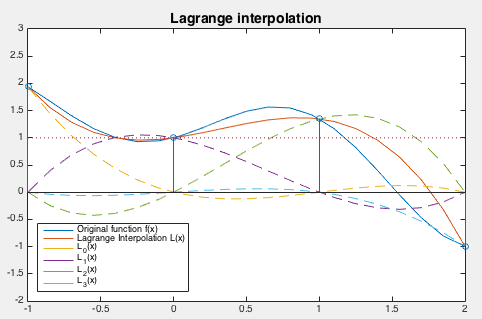Next: The Newton Polynomial Interpolation Up: Interpolation and Extrapolation Previous: Polynomial Interpolation
The polynomial 


 |
(15) |
 are the Lagrange basis polynomials of degree
are the Lagrange basis polynomials of degree  that
span the space of all nth degree polynomials:
that
span the space of all nth degree polynomials:
 |
(16) |
 , we get
, we get
 |
(17) |
 passes through all
passes through all  points:
points:
 |
(18) |
 at any other point
at any other point
 .
.
Specially, when 

 |
(19) |
Due to the uniqueness of the polynomial interpolation,

 |
(20) |
The computational complexity for calculating one of the 








To reduce the computational complexity, we express the
numerator of 

 |
(21) |
 can be found by evaluating
can be found by evaluating
 at
at  :
:
 |
(22) |
 which leads to the last equality due to L'Hôpital's
rule. Now the Lagrange basis polynomial can be expressed as
which leads to the last equality due to L'Hôpital's
rule. Now the Lagrange basis polynomial can be expressed as
 |
(23) |
 is the barycentric weight, and the
Lagrange interpolation can be written as:
is the barycentric weight, and the
Lagrange interpolation can be written as:
 |
(24) |
 for each
of the
for each
of the  samples of
samples of  is
is  (both for
(both for  and the
summation), and the total complexity for all
and the
summation), and the total complexity for all  samples is
samples is
 .
.
Example:
Approximate function




 |
Based on these points, we construct the Lagrange polynomials as
the basis functions of the polynomial space (instead of the power
functions in the previous example):
 |
 |
 |
|
 |
 |
 |
|
 |
 |
 |
|
 |
 |
 |
 . The
interpolating polynomial can be obtained as a weighted sum
of these basis functions:
. The
interpolating polynomial can be obtained as a weighted sum
of these basis functions:
 |
 previously found based on the power basis
functions, with the same error
previously found based on the power basis
functions, with the same error
 .
.

The Matlab code that implements the Lagrange interpolation (both methods) is listed below:
function [v L]=LI(u,x,y) % Lagrange Interpolation
% vectors x and y contain n+1 points and the corresponding function values
% vector u contains all discrete samples of the continuous argument of f(x)
n=length(x); % number of interpolating points
k=length(u); % number of discrete sample points
v=zeros(1,k); % Lagrange interpolation
L=ones(n,k); % Lagrange basis polynomials
for i=1:n
for j=1:n
if j~=i
L(i,:)=L(i,:).*(u-x(j))/(x(i)-x(j));
end
end
v=v+y(i)*L(i,:);
end
end
function [v L]=LInew(u,x,y) % Lagrange interpolation
% u: data points; (x,y) sample points
n=length(x); % number of sample points
m=length(u); % number of data points
L=ones(n,m); % Lagrange basis polynomials
v=zeros(1,m); % interpolation results
w=ones(1,m); % omega(x)
dw=ones(1,n); % omega'(x_i)
for i=1:n
w=w.*(u-x(i));
for j=1:n
if j~=i
dw(i)=dw(i)*(x(i)-x(j));
end
end
end
for i=1:n
L(i,:)=w./(u-x(i))/dw(i);
v=v+y(i)*L(i,:);
end
end